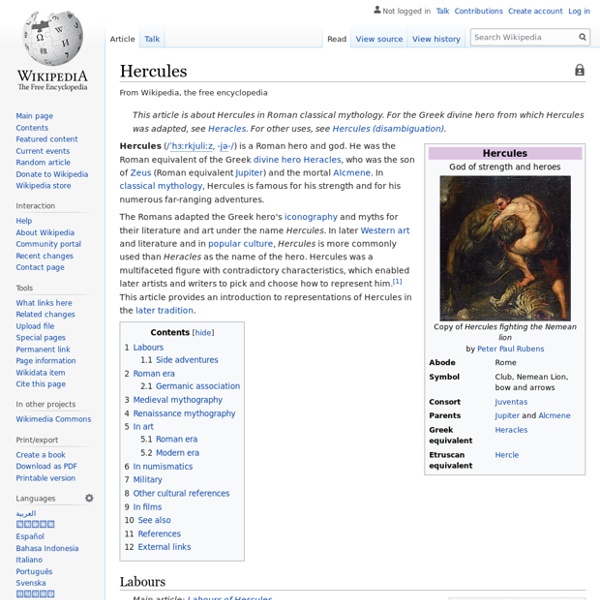Mares of Diomedes
Mythology[edit] After capturing the Cretan bull, Heracles was to steal the Mares. In one version of the story, Heracles brought a number of youths to help him. They took the mares and were chased by Diomedes and his men. Heracles was not aware that the horses, called Podargos (the swift), Lampon (the shining), Xanthos (the yellow) and Deinos (the terrible),[1] were kept tethered to a bronze manger because they were wild; their madness being attributed to an unnatural diet of human flesh.[2] Some versions say that they expelled fire when they breathed. They were man-eating and uncontrollable, and Heracles left his favoured companion, Abderus, in charge of them while he fought Diomedes, and found out that the boy was eaten.
Amphitryon
cover of Amphitryon theater play. Mythology[edit] Alcmene, who was pregnant and had been betrothed to Amphitryon by her father, refused to marry him until he had avenged the death of her brothers, all but one of whom had fallen in battle against the Taphians. It was on his return from this expedition that Electryon had been killed. Amphitryon accordingly took the field against the Taphians, accompanied by Creon, who had agreed to assist him on condition that he slew the Teumessian fox which had been sent by Dionysus to ravage the country.
Thrace
The Roman province of Thrace The Byzantine thema of Thrace. Map of Ancient Thrace made by Abraham Ortelius in 1585, stating both the names Thrace and Europe.
Alcmene
In Greek mythology, Alcmene () or Alcmena (; Ancient Greek: Ἀλκμήνη or Doric: Ἀλκμάνα, Latin: Alcumena means "strong in wrath"[1]) was the wife of Amphitryon by whom she bore two children, Iphicles and Laonome. She is better known as the mother of Heracles whose father was the god Zeus. Alcmene was also called Electryone (Ἠλεκτρυώνην), a patronymic name as a daughter of Electryon.[2] Mythology[edit] Background[edit]
Diomedes of Thrace
Hercules and Diomedes, from a 16th-century original at the Palazzo Vecchio in Florence, Italy; one of six marble statues representing "The Labours of Hercules" by Vincenzo de' Rossi.[1] Mythology[edit] Heracles encounters King Diomedes through performing his eighth labour. Eurystheus, King of Tiryns and Heracles cousin, had sent Heracles to capture the Mares of Diomedes after he had completed his seventh labour, capturing the Cretan Bull.
Hera
Goddess from Greek mythology, wife and sister of Zeus Hera is commonly seen with the animals she considers sacred, including the cow, lion and the peacock. Portrayed as majestic and solemn, often enthroned, and crowned with the polos (a high cylindrical crown worn by several of the Great Goddesses), Hera may hold a pomegranate in her hand, emblem of fertile blood and death and a substitute for the narcotic capsule of the opium poppy.[1] Scholar of Greek mythology Walter Burkert writes in Greek Religion, "Nevertheless, there are memories of an earlier aniconic representation, as a pillar in Argos and as a plank in Samos."[2] Etymology[edit]
Tydeus
Tydeus and Ismene. Side A from a Corinthian black-figure amphora, ca. 560 BC. In Greek mythology, Tydeus (/ˈtaɪdiəs, -djuːs, ˈtɪdiəs/; Ancient Greek: Τυδεύς Tūdeus) was an Aeolian hero of the generation before the Trojan War. He was one of the Seven Against Thebes, and the father of Diomedes, who is frequently known by the patronymic Tydides. Mythology[edit] Exile[edit]
Heracles
Origin Many popular stories were told of his life, the most famous being The Twelve Labours of Heracles; Alexandrian poets of the Hellenistic age drew his mythology into a high poetic and tragic atmosphere.[4] His figure, which initially drew on Near Eastern motifs such as the lion-fight, was widely known. Heracles was the greatest of Hellenic chthonic heroes, but unlike other Greek heroes, no tomb was identified as his. Heracles was both hero and god, as Pindar says heros theos; at the same festival sacrifice was made to him, first as a hero, with a chthonic libation, and then as a god, upon an altar: thus he embodies the closest Greek approach to a "demi-god".[4] Hero or god Heracles' role as a culture hero, whose death could be a subject of mythic telling (see below), was accepted into the Olympian Pantheon during Classical times.
Odysseus
legendary Greek king of Ithaca Odysseus (Greek: Ὀδυσσεύς, Ὀδυσεύς, Ὀdysseús [odysse͜ús]), also known by the Latin variant Ulysses (, ; Latin: Ulyssēs, Ulixēs), is a legendary Greek king of Ithaca and the hero of Homer's epic poem the Odyssey. Odysseus also plays a key role in Homer's Iliad and other works in that same epic cycle.
Athena
ancient Greek goddess of wisdom and battle strategy Athena[b] or Athene,[c] often given the epithet Pallas,[d] is an ancient Greek goddess associated with wisdom, handicraft, and warfare[3] who was later syncretized with the Roman goddess Minerva. Athena was regarded as the patron and protectress of various cities across Greece, particularly the city of Athens, from which she most likely received her name. She's usually shown in art wearing a helmet and holding a spear. Her major symbols include owls, olive trees, snakes, and the Gorgoneion.



